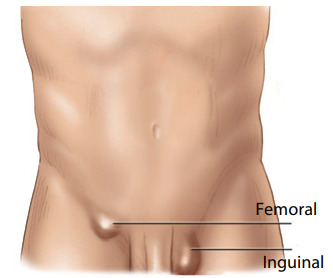Glossary
Advance directives: Documents signed by a competent person giving direction to health care providers about treatment choices.
Computerized tomography (CT) scan: A diagnostic test X ray and a computer to create a detailed, three-dimensional picture of your abdomen. A CT scan is commonly used to detect abnormalities or disease inside the abdomen. It is sometimes used to find a hernia not obvious during the physical exam.
Digital exam: The examiner will place their gloved index finger gently into the scrotal sac and feel up to the inguinal ring in the groin. Then the patient is asked to strain.
Electrocardiogram (ECG): Measures the rate and regularity of heartbeats and any damage to the heart.
General anesthesia: A treatment with certain medicines that puts you into a deep sleep so you do not feel pain during surgery.
Hematoma: A collection of blood that has leaked into the tissues of the skin or in an organ, resulting from cutting in surgery or the blood’s inability to form a clot.
Incarceration: The protrusion or constriction of an organ through the wall of the cavity that normally contains it.
Local anesthesia: The loss of sensation only in the area of the body where an anesthetic drug is applied or injected.
Nasogastric tube: A soft plastic tube inserted in the nose and down to the stomach which is used to empty the stomach of contents and gases to rest the bowel.
Seroma: A collection of serous (clear/yellow) fluid.
Strangulation: Part of the intestine or fat is squeezed in the hernia sac and blood supply to the tissue is cut off.
Ultrasound: Sound waves are used to determine the location of deep structures in the body. A hand roller is placed on top of clear gel and rolled across the abdomen. An ultrasound may be used to find a hernia that is not obvious during the physical exam.
Urinalysis: A visual and chemical examination of the urine, most often used to screen for urinary tract infections and kidney disease.
DISCLAIMER
The American College of Surgeons (ACS) is a scientific and educational association of surgeons that was founded in 1913 to improve the quality of care for the surgical patient by setting high standards for surgical education and practice. The ACS endeavors to provide procedure education for prospective patients and those who educate them. It is not intended to take the place of a discussion with a qualified surgeon who is familiar with your situation. The ACS makes every effort to provide information that is accurate and timely, but makes no guarantee in this regard.
Reviewed and revised 2016, 2018 & 2022 by:
David Feliciano, MD, FACS
Mary Hawn, MD, FACS
Kathleen Heneghan, PhD, MSN, RN, FAACE
Nancy Strand, MPH, RN



